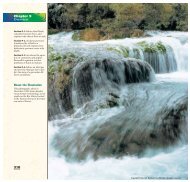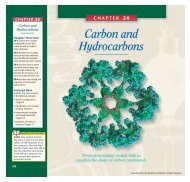Physical Characteristics of Gases
Physical Characteristics of Gases
Physical Characteristics of Gases
Create successful ePaper yourself
Turn your PDF publications into a flip-book with our unique Google optimized e-Paper software.
force<br />
pressure =<br />
area<br />
The SI unit for force is the newton, abbreviated N. It is the force that will<br />
increase the speed <strong>of</strong> a one kilogram mass by one meter per second each<br />
second it is applied. At Earth’s surface, each kilogram <strong>of</strong> mass exerts 9.8 N<br />
<strong>of</strong> force, due to gravity. Consider a ballet dancer with a mass <strong>of</strong> 51 kg, as<br />
shown in Figure 10-4. A mass <strong>of</strong> 51 kg exerts a force <strong>of</strong> 500 N (51 × 9.8)<br />
on Earth’s surface. No matter how the dancer stands, she exerts that much<br />
force against the floor. However, the pressure she exerts against the floor<br />
depends on the area <strong>of</strong> contact.When she rests her weight on the soles <strong>of</strong><br />
both feet, as shown in Figure 10-4(a), the area <strong>of</strong> contact with the floor is<br />
about 325 cm 2 . The pressure, or force per unit area, when she stands in<br />
this manner is 500 N/325 cm 2 . That equals roughly 1.5 N/cm 2 . When she<br />
stands on her toes, as in Figure 10-4(b), the total area <strong>of</strong> contact with the<br />
floor is only 13 cm 2 .The pressure exerted is then equal to 500 N/13 cm 2 —<br />
roughly 38.5 N/cm 2 .And when she stands on one toe, as in Figure 10-4(c),<br />
the pressure she exerts is twice that, or about 77 N/cm 2 . Thus, the same<br />
force applied to a smaller area results in a greater pressure.<br />
Gas molecules exert pressure on any surface with which they collide.<br />
The pressure exerted by a gas depends on volume, temperature, and the<br />
number <strong>of</strong> molecules present.<br />
The atmosphere—the blanket <strong>of</strong> air surrounding Earth—exerts pressure.<br />
Figure 10-5 shows that atmospheric pressure at sea level is about<br />
equal to the weight <strong>of</strong> a 1.03 kg mass per square centimeter <strong>of</strong> surface, or<br />
10.1 N/cm 2 . The pressure <strong>of</strong> the atmosphere can be thought <strong>of</strong> as caused<br />
by the weight <strong>of</strong> the gases that compose the atmosphere.The atmosphere<br />
contains about 78% nitrogen, 21% oxygen, and 1% other gases, including<br />
Force<br />
1 atm <strong>of</strong><br />
pressure<br />
is the<br />
force <strong>of</strong><br />
101.325 kN<br />
on 1 m 2<br />
Pressure<br />
Oxygen, O 2<br />
Copyright © by Holt, Rinehart and Winston. All rights reserved.<br />
Nitrogen, N 2<br />
Earth’s surface<br />
Module 6: Gas Laws<br />
FIGURE 10-5 The gases that<br />
make up Earth’s atmosphere—mostly<br />
nitrogen and oxygen—press down<br />
against Earth’s surface. The gas<br />
molecules collide with the surface,<br />
creating a pressure <strong>of</strong> 10.1 N/cm 2 .<br />
PHYSICAL CHARACTERISTICS OF GASES 309<br />
SECTION 10-2<br />
Visual Strategy<br />
FIGURE 10-5 Ask students to explain<br />
why airplanes that fly at high altitudes<br />
must have pressurized cabins.<br />
Alternative Assessment<br />
The following chart shows changes<br />
in air pressure in relation to altitude<br />
above Earth’s surface. Have students<br />
graph these data, then discuss the<br />
relationship shown between altitude<br />
and atmospheric pressure.<br />
Percent <strong>of</strong> sea-<br />
Altitude (km) level pressure<br />
0 100<br />
5.6 50<br />
16.2 10<br />
31.2 1<br />
48.1 0.1<br />
65.1 0.01<br />
79.2 0.001<br />
Did You Know?<br />
The average number <strong>of</strong> collisions<br />
per second experienced by an air<br />
molecule near sea level is about<br />
7 × 10 9 ; at an altitude <strong>of</strong> 600 km,<br />
it experiences an average <strong>of</strong> about<br />
one collision per minute.<br />
Module 6: Gas Laws<br />
Topic: <strong>Gases</strong><br />
Section a <strong>of</strong> this engaging tutorial<br />
reviews and reinforces understanding<br />
<strong>of</strong> gases.<br />
309

















